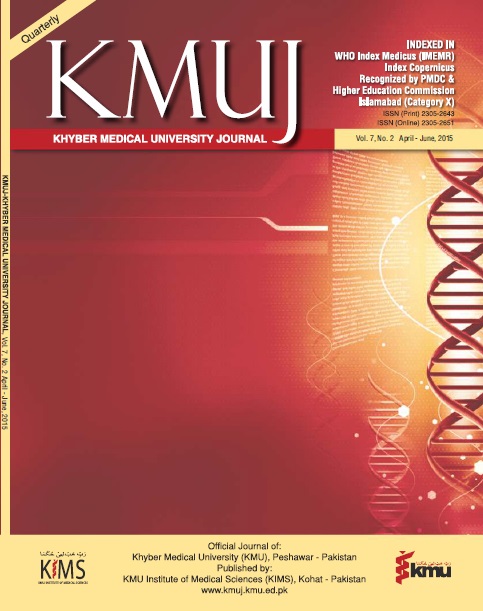DAILY FOLLOW UP NOTES’ ACCURACY ACCORDING TO SOAP (SUBJECTIVE, OBJECTIVE, ASSESSMENT, PLAN) FORMAT
Main Article Content
Abstract
A
Objective: To assess the accuracy of daily follow up notes in accordance with SOAP (subjective, objective, assessment, plan) format and determine the awareness of standard guidelines among the house officers and post-graduates at Ziauddin Hospital.
Methods: A cross-sectional study conducted over a one month period. A total 460 follow up notes documented by house officers and postgraduate trainees from four departments were assessed via a preformed checklist based on the SOAP format. In addition, house officers and post graduate trainees were assessed regarding their awareness of SOAP format.
Results: The most common component addressed (n=420, 91.3%) was the active complaint of the patient and variable least addressed was imaging studies (n=21, 4.6%).
The second part of the study demonstrated that 87% (n=20) of the doctors knew about the exact components of the SOAP format. This format was used by 78.3% (n=18) participants to put daily follow-up notes. The 21.7% (n=5) who do not put follow-up notes according to the SOAP format: 20% (n=5) believe it is of no use, 40% (n=9) find it time-consuming and 40% (n=9) do not do so because no one asks them to follow the SOAP format.
Conclusion: Level of accuracy of daily follow up notes on the basis of SOAP format at our hospital was not up to the mark. Awareness of the house officers and postgraduate trainees regarding the SOAP format was adequate; however there is a need to emphasize the importance of SOAP for every new batch of house officers and postgraduates.
Key words: Documentation (MeSH), awareness (MeSH), SOAP format (Non-MeSH), daily follow-up notes (Non-MeSH)Article Details
Work published in KMUJ is licensed under a
Creative Commons Attribution 4.0 License
Authors are permitted and encouraged to post their work online (e.g., in institutional repositories or on their website) prior to and during the submission process, as it can lead to productive exchanges, as well as earlier and greater citation of published work.
(e.g., in institutional repositories or on their website) prior to and during the submission process, as it can lead to productive exchanges, as well as earlier and greater citation of published work.
References
REFERENCES:
Wood DL. “Documentation guidelines: evolution, future direction, and compliance.” The Am J Med110.4 (2001): 332-334.
Murphy BJ. “Principles of good medical record documentation” Med Pract Manage 16.5 (2001): 258-260.
Soto CM, Kleinman KP, Simon SR. “Quality and correlates of medical record documentation in the ambulatory care setting.” BMC Health Serv Res 2002;2(1):22.
Masood J, et al. “Daily progress notes by surgical interns: An assessment of quality.” Pak J Med Sci 26.4 (2010): 822-826.
Cameron, Susan, Imani TS. “Learning to write case notes using the SOAP format.” J Couns Dev 80.3 (2002): 286-292.
Kettenbach G. “Writing SOAP notes: With patient/client management” (Accessed on 3 Nov. 2014). FA Davis Publishing; 2004.
Guidelines and Examples on the SOAP Format for Chart Notes. HTNP Manual of Operations. Appendix 2. Available from: http://www.hptn.org/web%20documents/HPTNMOP/Appendices/Appendix2.pdf
Cameron S.: “Learning to Write Case Notes Using the SOAP Format.” J Couns Dev 2002. Volume 80 (286-292).
Kibble, Jonathan, Penelope AH, and Loren N. “Use of modified SOAP notes and peer-led small-group discussion in a medical physiology course: addressing the hidden curriculum.” Adv Physiol Ed 30.4 (2006): 230-236.
Mann, Robin, John W. “Standards in medical record keeping.” Clinical Medicine 3.4 (2003): 329-332.
Kardos, Gary G. “Failure to document.” Am J Med Qual 6.3 (1991): 99-103.
Mehmood, Khalid, Shahid S, and Ilyas S. “Audit of medical record documentation of patients admitted to a medical unit in a teaching hospital NWFP Pakistan.” JPMI (Peshawar-Pakistan) 21.2 (2011)
Chamisa, I, Zulu BMW. “Setting the records straight-a prospective audit of the quality of case notes in a surgical department” Afr J Surg 45.3 (2009): 92-94.
Osborn GD, Pike H, Smith M, Winter R, Vaughan-Williams E. “Quality of clinical case note entries: how good are we at achieving set standards?” Ann R Coll Surg Engl. 2005 Nov; 87(6):458-60.
Jacks, Mary E, Christine B, and Douglas M. “Short-and Long-Term Effects of Training on Dental Hygiene Faculty Members’ Capacity to Write SOAP Notes.” J Dent Edu 72.6 (2008): 719-724.
O'Connor, Alan E., Louise F, and Jennifer R. “Do preformatted charts improve doctors' documentation in a rural hospital emergency department? A prospective trial.” The N Z Med J 114.1141 (2001): 443-444.
